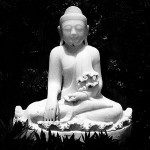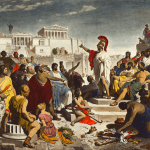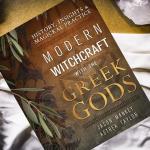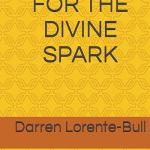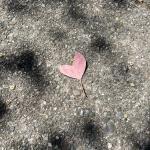I remember my first night at my first Pagan festival, the 1998 Free Spirit Gathering. Of course, I found myself at the Fire Circle. Well, we’d done dance and drum fire circles before in the Coven of Lovin’ — much much smaller ones, but I knew how this worked, and so I joined in.
It was a warm night, and FSG is a clothing optional event. Thus, there were some naked people dancing around with me. That was a first. Well, okay, I could deal with it. I didn’t want to bump up against any sweaty naked men, but I didn’t want to bump up against any sweaty clothed men either, so as long as there was plenty of space, no problem. There might have been a naked woman or two there also, but I was an adult and had seen naked women before and it was not as big a deal as it was when I was seventeen.
So, a bit to my own surprise, I was okay with naked people dancing around with me. I just tried not to look too much. But I couldn’t imagine myself ever joining them in their unclothed state. That was just too wild, too far out. Nope. Me, naked in a (sort of) public place? Not going to happen. No way.
Oh, sure, as I got hot I took off my shirt. But as a male that was no different than going to the pool or mowing the lawn on a hot day, I was not breaking any taboos there.
But as I continued to dance, I learned three important things. One: fire is hot. When you’re dancing close to it on a hot night, you want maximum cooling surface exposed for sweat evaporation.
Two: fire is sacred. You want to expose as much of your skin to it as you can, to best absorb its energy.
Three: in this sacred space, in this time outside of time, I felt safe. I felt unconditioned. I felt free. So, after an hour or two, off came the pants.
This is the first nude photo of me on the internet…as far as I know
I danced naked around a fire to the beat of the drums.
I broke one of our society’s strongest taboos. The humor columnist Mike Nichols once noted, “Take off all your clothes and walk down the street waving a machete and firing an Uzi, and terrified citizens will phone the police and report, ‘There’s a naked person outside!'” [quoted in Lawrence, 229]
There is power in breaking such a rule.
I used to have those dreams where I showed up at work or at school and suddenly realized, to my absolute mortification, that I was naked. But after a few years of attending clothing-optional festivals, of dancing naked around the fire or just letting myself air-dry walking back to camp from the shower, I had that dream once final time. This time, though, when I looked down while talking to someone and noticed I was naked, I said, “Oh. Anyway…”, and calmly went about my dream business.
I have not had that dream since. A fear so deep it reached into my dreams has been removed from my brain. That, my friends, is magic power.
And nakedness has that power because it is wild. “Civilized” people wear clothes; the “savage”, the “wild” one, goes naked.
That’s why nudity has been found in Neo paganismsince its 19th and early 20th century roots. It was part of the German lebensreform movement of the 1890s,[Kennedy, 56] which came to be an influence on the American counter-culture. (It strikes me that it may also may have been, through intermediaries, the ultimate source for Gardner’s practice of naturalism, but I’m just speculating.) It’s in the proto-Pagan writings of Whitman: “Is not nakedness then indecent? No, not inherently. It is your thought, your sophistication, your fear, your respectability, that is indecent.”[Whitman] It’s in Leland’s Aradia: “And thus shall it be done: all shall sit down to the supper all naked, men and women…”[Leland] It was used in the initiation rites of Crowley’s OTO.[Regardie, 177]
Nudity is a powerful way to raise energy.
So I make it a point to spend a little time going around skyclad at any event I can, not so much because I need that energy myself — it’s already done its thing for me — but so that I can show others that it’s okay to try it. To step outside the taboo and be wild.
But from my casual observation, it seems like fewer people are taking advantage of this primal source of power. (This is a topic that came up when our good friend Jason Mankey had me as a guest on his “Raise the Horns” podcast.)
Some folks, of course, just aren’t comfortable being seen unclothed. But that’s the point: you don’t raise magical energy by doing familiar, comfortable things. And some folks are concerned about covering up from the sun, what with the hole in the ozone and all. Which is fine, but the sun does go down, and sunscreen will work its magic on all parts of you.
What has really startled me is that lately I’ve encountered some Pagans who were not just uncomfortable going skyclad themselves but were outright hostile to the idea of other Pagans doing so. One even claimed that it must surely be illegal for adults to be nude in front of children — which would be a shock for nudist camps that have served families for decades, not to mention the local Y where kids in the locker room might see me change into my swimming trunks.
It seems that nakedness is a little too wild for some contemporary Pagans.
I am not a witch, but Peter Grey’s essay “Rewilding Witchcraft” has been getting a lot of attention the past few months. It makes some questionable arguments — for example, the story of how the reintroduction of wolves in Yellowstone created an “ecological miracle” seems to be more myth than fact[Middleton], and his view that some inevitable nuclear catastrophe will eliminate all life on the planet for 100 million years is not based in any fact. The “living Earth” is not “fragile”: life will be here on this planet in some form even if we do our absolute worst. The question that faces us is whether we can be smart and mature enough to be part of it, or whether we’ll leave the Earth to other species.
But putting aside the ecological eschatology that makes up the bulk of the essay, Grey (perhaps incidentally) makes a broader point about “wildness”, one with which I agree wholeheartedly if I substitute the more general “Paganism” for “Witchcraft”:
I will argue that Witchcraft is quintessentially wild, ambivalent, ambiguous, queer. It is not something that can be socialised, standing as it does in that liminal space between the seen and unseen worlds. Spatially the realm of witchcraft is the hedge, the crossroads, the dreaming point where the world of men and of spirits parlay through the penetrated body of someone who is outside of the normal rules of culture….
…
My argument is that witchcraft became too tame…[Grey]
1998 was not that long ago. But in 16 years since that first festival I’ve seen a distinct change in the culture, a “de-wilding” and therefore a loss of power — and perhaps even a loss of purpose.
There’s an idea from Joseph Campbell that has greatly influenced my thinking and my work the past few years. In his essay “The Symbol Without Meaning”, Campbell points out the difference between the direct religious experience of Paleolithic, gatherer-hunter, shamanistic cultures and the mediated priestly religions of Neolithic (and later) agricultural civilizations. That Neolithic social order, Campbell says, is dissolving in the wake of the Industrial Revolution, and “what is required of us all…is much more the fearless self-sufficiency of our shamanistic inheritance than the timorous piety of the priest-guided Neolithic.”[Campbell, 189]
In other words, we must get wild with our spirituality, untamed and direct.
It seems to me that this is why the Neopagan movement exists in the first place, a reaction to the inability of “civilized” religion to deal with the circumstances in which humanity finds itself. We are on a quest for something more direct.
Something untamed.
Something unafraid to stand naked.
References:
Campbell, Joseph. The Flight of the Wild Gander. New York, N.Y: HarperPerennial, 1990.
Grey, Peter. “Rewilding Witchcraft”. <http://scarletimprint.com/2014/06/rewilding-witchcraft/>
Kennedy, Gordon. Children of the Sun. Ojai, California: Nivaria Press, 1998.
Lawrence, Cooper and Scott Baio. Cult of Celebrity: What Our Fascination with the Stars Reveals about Us.Rowman & Littlefield, 2009. <http://books.google.com/books?id=hQDPYS13CwAC&pg=PA229>
Leland, Charles G. Aradia: The Gospel of the Witches. <http://www.sacred-texts.com/pag/aradia/ara04.htm>
Middleton, Arthur. “Is the Wolf a Real American Hero?” New York Times 10 Mar 2014: A21. <http://www.nytimes.com/2014/03/10/opinion/is-the-wolf-a-real-american-hero.html>
Regardie, Israel. The Eye in the Triangle. Tempe: New Falcon Publications, 1993.
Valiente, Doreen. “The Charge Of The Goddess”. <http://www.doreenvaliente.com/Doreen-Valiente-Poetry-11.php>
Whitman, Walt. “Specimen Days” Prose works, by Walt Whitman. Philadelphia: David McKay, 1892. <http://www.bartleby.com/229/1133.html>
If you’re interested in this idea of Neopaganism as a response to industrial civilization, it’s one of the themes I cover in my book Why Buddha Touched the Earth. You could buy a copy.
Or you might choose to join a new Facebook group on “Zen Paganism” I’ve set up. And don’t forget to “like” Patheos Pagan over there, too.


